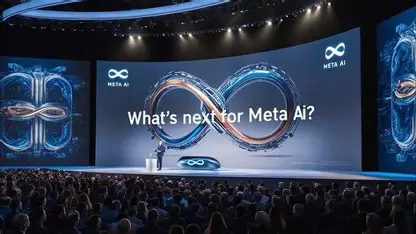4 Things Industry 4.0 – Superintelligence, Supply Chains & Spark: The Forces Shaping a New Industrial Revolution

Presented by

Happy July 4th Week, freedom-loving innovators!
As fireworks get ready to light up the sky, the world of Industry 4.0 is launching a few rockets of its own. Meta just declared independence from the old AI playbook with its new Superintelligence Labs, Siemens is investing in U.S. manufacturing to help power the grid of tomorrow, and AWS just watched a major AI leader exit stage left. We're also zooming in on the unsung hero of the semiconductor revolution: chip packaging.
Plus, in this week’s Learning Lens, AWS shows us how AI-powered dev tools are quietly transforming database workflows—and in Byte Sized Brilliance, we uncover why NASA’s internet speeds might be the most patriotic flex of all.
Let’s fire up this week’s headlines and spark some insight.
Meta Launches Superintelligence Labs, Taps Industry Heavyweights

Meta has launched a new division called Meta Superintelligence Labs (MSL) to accelerate development of advanced AI systems. The company is consolidating its AI efforts—including teams behind the Llama models and FAIR—under the leadership of Alexandr Wang, former Scale AI CEO, and Nat Friedman, former GitHub CEO. Backed by Meta’s scale and recent high-profile hires from OpenAI, DeepMind, and Anthropic, the initiative signals a deeper push into AI innovation at a time of intense industry competition.
👉 Explore how Meta’s superintelligence effort could reshape the AI talent war and research landscape.
AWS AI Leader Departs Amid Intensifying Talent Competition

Amazon Web Services (AWS) has announced the departure of Vasi Philomin, Vice President overseeing generative AI initiatives and the Amazon Bedrock service. Philomin, instrumental in developing foundational models like Amazon Titan, left in June 2025 to join another company. His responsibilities have been partially assumed by Rajesh Sheth, previously in charge of Amazon Elastic Block Store. This leadership change occurs as AWS intensifies its efforts in AI, investing $8 billion in AI startup Anthropic and launching new AI models, Nova and Sonic, to compete with rivals like OpenAI and Google.
👉 Explore how AWS's leadership changes reflect the broader competition for AI talent.
Google Commits to Fusion Energy with Commonwealth Deal

Google has signed a power purchase agreement with Commonwealth Fusion Systems (CFS) to buy 200 megawatts of electricity from a planned fusion energy plant in Chesterfield County, Virginia. The facility, expected to be operational in the early 2030s, aims to be one of the first fusion power stations connected to the grid. This agreement marks Google's first energy procurement deal with a fusion company and includes an increased investment in CFS, a startup that has raised over $2 billion and is backed by investors like Bill Gates' Breakthrough Energy Ventures. The deal represents a significant step toward commercializing fusion energy, which promises nearly limitless, carbon-free power.
Sponsor Message

From Edge to Enterprise: Why Engineers Trust WinCC OA
WinCC OA goes beyond traditional SCADA—it’s a fully extensible industrial platform engineered for Industry 4.0 realities. Built to scale and designed for openness, it enables total system integration across brownfield and greenfield environments alike.
Whether you’re implementing a Unified Namespace or bridging IT/OT, WinCC OA delivers unmatched adaptability with:
- Smart Architecture – Modular design supports evolving infrastructure demands
- Open Protocol Support – Connects OPC UA, MQTT, REST, and many more
- Security by Design – Built-in features meet modern cybersecurity standards
- Real-Time Control – High-performance processing for time-critical operations
- Unified Management – Centralized visibility across distributed systems
- Developer-Ready Tools – Full toolkit for custom logic, UIs, and automation
Used across energy, manufacturing, water, and transport sectors, WinCC OA is trusted by engineers who demand open standards, long-term viability, and uncompromising control.
Discover WinCC OA World
Ready to build with WinCC OA
Request your free WinCC OA Evaluation License now!
Siemens Energy to Manufacture Large Power Transformers in U.S. by 2027

Siemens Energy has announced plans to begin production of large industrial power transformers at its Charlotte, North Carolina facility by early 2027. This initiative aims to reduce the U.S.'s reliance on imports, as over 80% of such transformers are currently sourced from abroad. The company anticipates that by 2050, approximately $2 trillion will be invested in updating the aging U.S. power grid, driven by increasing electricity demand from data centers and artificial intelligence technologies. The Charlotte facility has the capacity for further expansion to meet future demand. Siemens Energy, which generates over 20% of its global sales in the U.S., employs around 12,000 people across various production plants in the country.
Industry 4.0 Highlights
Ford CEO Warns of Chinese EV Industry's Rapid Advancement
At the Aspen Ideas Festival, Ford CEO Jim Farley expressed significant concern over China's dominance in the electric vehicle (EV) sector, describing it as "the most humbling thing" he has ever seen. Highlighting that China produces 70% of the world's EVs, Farley praised Chinese automakers for their advanced in-vehicle technology, seamless digital integration, and lower production costs. He noted that tech firms like Huawei and Xiaomi have transformed vehicle experiences, offering features such as automatic phone integration. Farley emphasized that if Ford fails to keep up in this global EV competition, the company's future is at risk.
👉 Explore how China's advancements in EV technology are influencing global automotive strategies.
Chip Packaging Emerges as Critical Frontier in Semiconductor Innovation
As traditional chip miniaturization approaches physical limits, advanced packaging techniques are becoming essential for enhancing semiconductor performance. By integrating multiple chips into compact, high-performance assemblies, these methods improve speed, reduce power consumption, and enable functionalities vital for applications like AI, 5G, and autonomous vehicles. Techniques such as 2.5D and 3D integration, chiplets, and fan-out wafer-level packaging are reshaping the industry. Companies like TSMC, Samsung, and Intel are investing heavily in these technologies, with projections estimating the advanced packaging market could reach $116 billion by 2027. This shift underscores the growing importance of packaging in driving the next wave of semiconductor innovation.
👉 Explore how advanced chip packaging is redefining the semiconductor landscape.
Learning Lens

Accelerating AWS Database Development with MCP Servers
AWS has introduced Model Context Protocol (MCP) servers to enhance database development workflows. These servers provide AI assistants with real-time access to database schemas and metadata, enabling context-aware code suggestions and automated test generation. By integrating MCP servers with services like Amazon Aurora, DynamoDB, and ElastiCache, developers can streamline tasks such as schema exploration, query optimization, and dashboard creation. This approach reduces context switching and accelerates development cycles in complex environments.
👉 Learn more: AWS Database Blog
Byte-Sized Brilliance
NASA’s Internet Is Faster Than Yours — Way Faster
NASA’s High-Speed Research and Engineering Network (NREN) can hit speeds up to 91 gigabits per second. That’s nearly 13,000 times faster than the average U.S. home connection. While you're waiting for your cat video to buffer, NASA could transmit the entire contents of Netflix in seconds… twice. It turns out rocket science includes Wi-Fi.
We Value your Feedback.
Click on the link below to provide us with your thoughts.
|
|
|
|
|
|



Responses